Competitive Strategy: Business Models & CAGE in Higher Education
VerifiedAdded on 2023/06/15
|9
|1698
|439
Essay
AI Summary
This essay delves into the critical aspects of competitive strategy within the higher education industry, emphasizing the importance of strategic planning, business model innovation, and the application of the CAGE framework. It highlights the necessity for higher education institutions to adapt and innovate in response to fluctuating enrollments, funding challenges, and evolving student demographics. The essay uses examples such as Cornell University's strategic focus on faculty excellence and the University of Southern Queensland's successful adoption of online education to illustrate effective strategies. Conversely, it examines instances where poor strategic execution or failure to innovate has led to decline, such as the case of Kenyan universities and the University of Illinois Urbana-Champaign. Furthermore, the essay underscores the significance of the CAGE framework in guiding internationalization efforts, citing the University of Oxford's Commonwealth Scholarships as a successful example of leveraging cultural and economic similarities to attract international students. The analysis concludes that a well-defined and adaptable strategy, coupled with business model innovation and a nuanced understanding of international dynamics through the CAGE framework, is essential for higher education institutions to thrive in an increasingly competitive global landscape. Desklib provides a platform to explore more solved assignments.
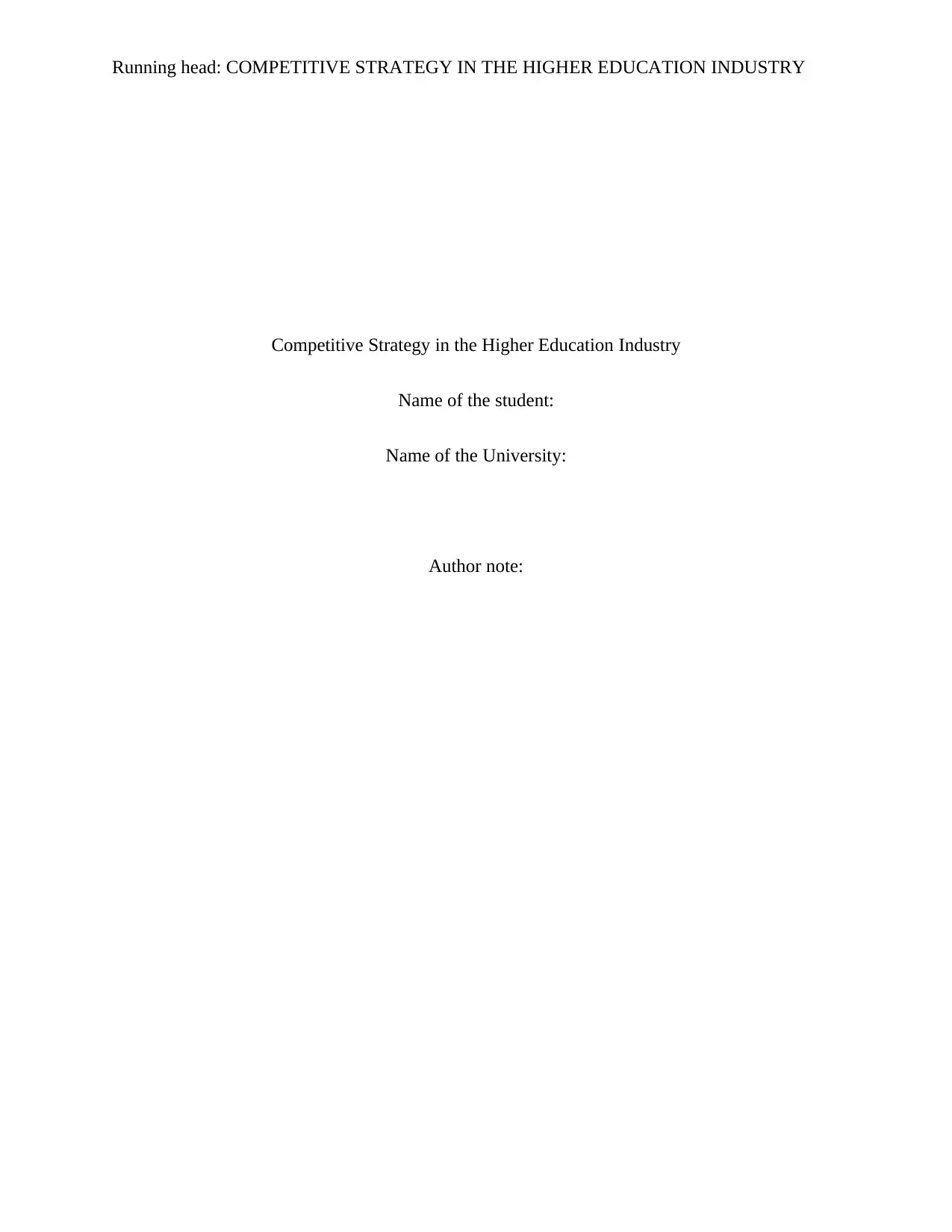
Running head: COMPETITIVE STRATEGY IN THE HIGHER EDUCATION INDUSTRY
Competitive Strategy in the Higher Education Industry
Name of the student:
Name of the University:
Author note:
Competitive Strategy in the Higher Education Industry
Name of the student:
Name of the University:
Author note:
Paraphrase This Document
Need a fresh take? Get an instant paraphrase of this document with our AI Paraphraser
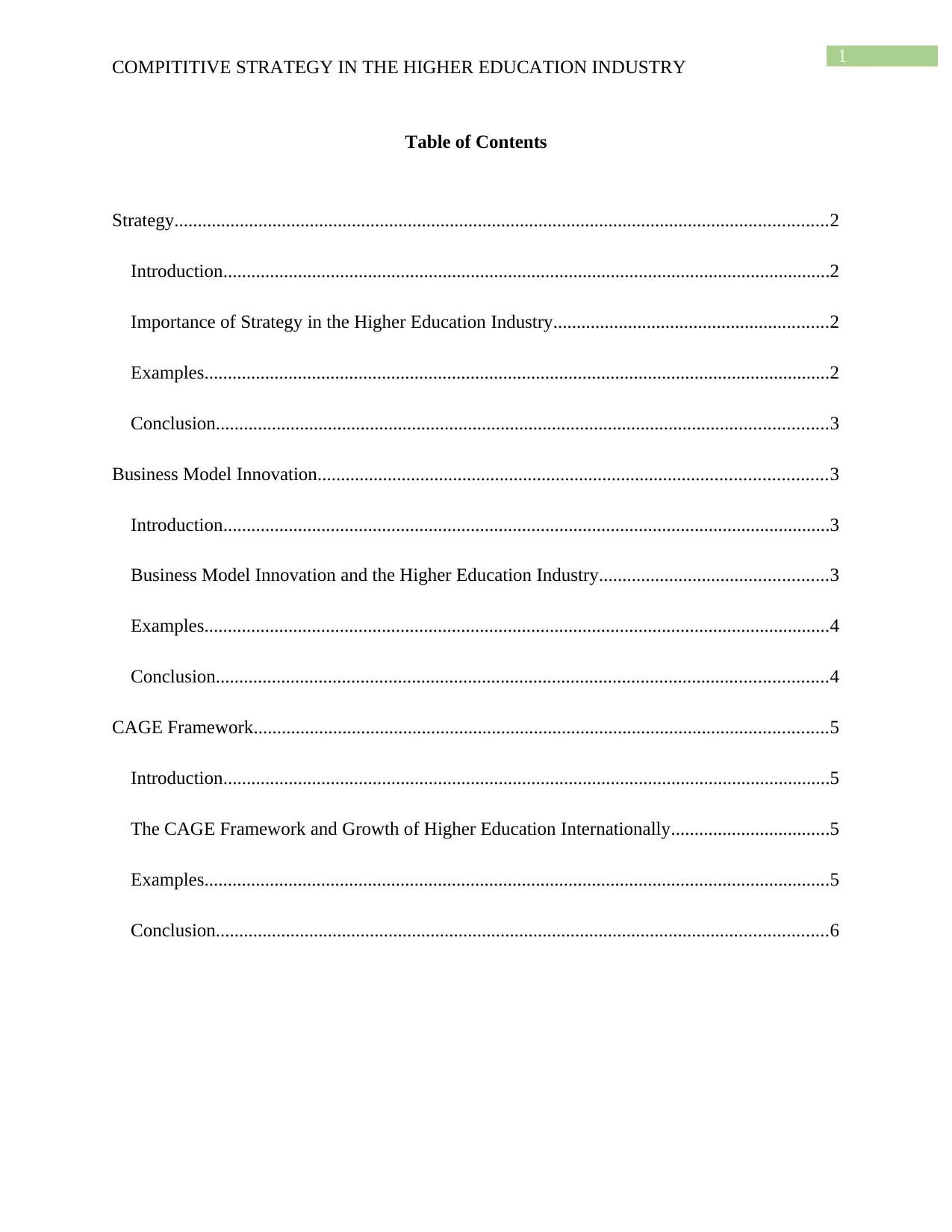
1
COMPITITIVE STRATEGY IN THE HIGHER EDUCATION INDUSTRY
Table of Contents
Strategy............................................................................................................................................2
Introduction..................................................................................................................................2
Importance of Strategy in the Higher Education Industry...........................................................2
Examples......................................................................................................................................2
Conclusion...................................................................................................................................3
Business Model Innovation.............................................................................................................3
Introduction..................................................................................................................................3
Business Model Innovation and the Higher Education Industry.................................................3
Examples......................................................................................................................................4
Conclusion...................................................................................................................................4
CAGE Framework...........................................................................................................................5
Introduction..................................................................................................................................5
The CAGE Framework and Growth of Higher Education Internationally..................................5
Examples......................................................................................................................................5
Conclusion...................................................................................................................................6
COMPITITIVE STRATEGY IN THE HIGHER EDUCATION INDUSTRY
Table of Contents
Strategy............................................................................................................................................2
Introduction..................................................................................................................................2
Importance of Strategy in the Higher Education Industry...........................................................2
Examples......................................................................................................................................2
Conclusion...................................................................................................................................3
Business Model Innovation.............................................................................................................3
Introduction..................................................................................................................................3
Business Model Innovation and the Higher Education Industry.................................................3
Examples......................................................................................................................................4
Conclusion...................................................................................................................................4
CAGE Framework...........................................................................................................................5
Introduction..................................................................................................................................5
The CAGE Framework and Growth of Higher Education Internationally..................................5
Examples......................................................................................................................................5
Conclusion...................................................................................................................................6
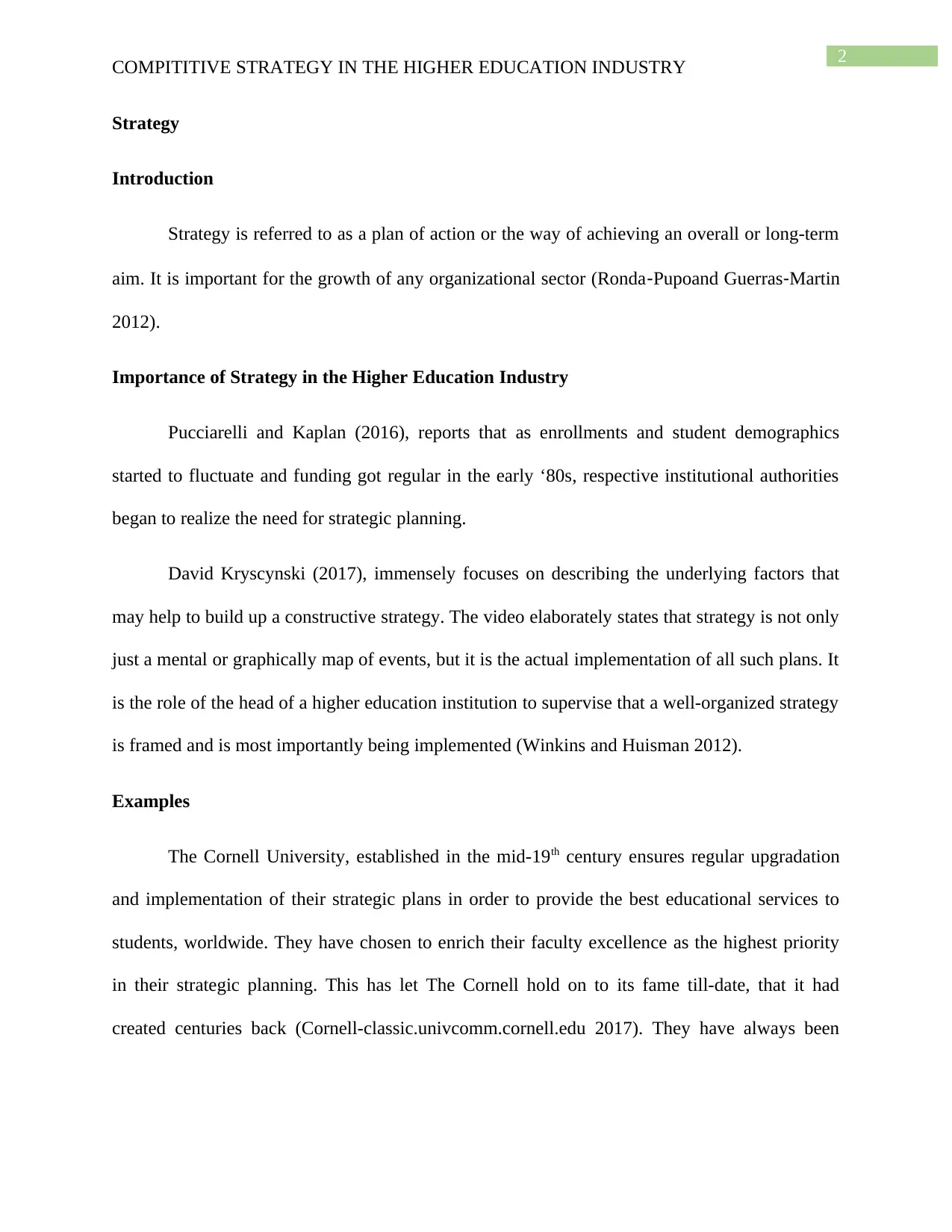
2
COMPITITIVE STRATEGY IN THE HIGHER EDUCATION INDUSTRY
Strategy
Introduction
Strategy is referred to as a plan of action or the way of achieving an overall or long-term
aim. It is important for the growth of any organizational sector (Ronda‐Pupoand Guerras‐Martin
2012).
Importance of Strategy in the Higher Education Industry
Pucciarelli and Kaplan (2016), reports that as enrollments and student demographics
started to fluctuate and funding got regular in the early ‘80s, respective institutional authorities
began to realize the need for strategic planning.
David Kryscynski (2017), immensely focuses on describing the underlying factors that
may help to build up a constructive strategy. The video elaborately states that strategy is not only
just a mental or graphically map of events, but it is the actual implementation of all such plans. It
is the role of the head of a higher education institution to supervise that a well-organized strategy
is framed and is most importantly being implemented (Winkins and Huisman 2012).
Examples
The Cornell University, established in the mid-19th century ensures regular upgradation
and implementation of their strategic plans in order to provide the best educational services to
students, worldwide. They have chosen to enrich their faculty excellence as the highest priority
in their strategic planning. This has let The Cornell hold on to its fame till-date, that it had
created centuries back (Cornell-classic.univcomm.cornell.edu 2017). They have always been
COMPITITIVE STRATEGY IN THE HIGHER EDUCATION INDUSTRY
Strategy
Introduction
Strategy is referred to as a plan of action or the way of achieving an overall or long-term
aim. It is important for the growth of any organizational sector (Ronda‐Pupoand Guerras‐Martin
2012).
Importance of Strategy in the Higher Education Industry
Pucciarelli and Kaplan (2016), reports that as enrollments and student demographics
started to fluctuate and funding got regular in the early ‘80s, respective institutional authorities
began to realize the need for strategic planning.
David Kryscynski (2017), immensely focuses on describing the underlying factors that
may help to build up a constructive strategy. The video elaborately states that strategy is not only
just a mental or graphically map of events, but it is the actual implementation of all such plans. It
is the role of the head of a higher education institution to supervise that a well-organized strategy
is framed and is most importantly being implemented (Winkins and Huisman 2012).
Examples
The Cornell University, established in the mid-19th century ensures regular upgradation
and implementation of their strategic plans in order to provide the best educational services to
students, worldwide. They have chosen to enrich their faculty excellence as the highest priority
in their strategic planning. This has let The Cornell hold on to its fame till-date, that it had
created centuries back (Cornell-classic.univcomm.cornell.edu 2017). They have always been
⊘ This is a preview!⊘
Do you want full access?
Subscribe today to unlock all pages.

Trusted by 1+ million students worldwide
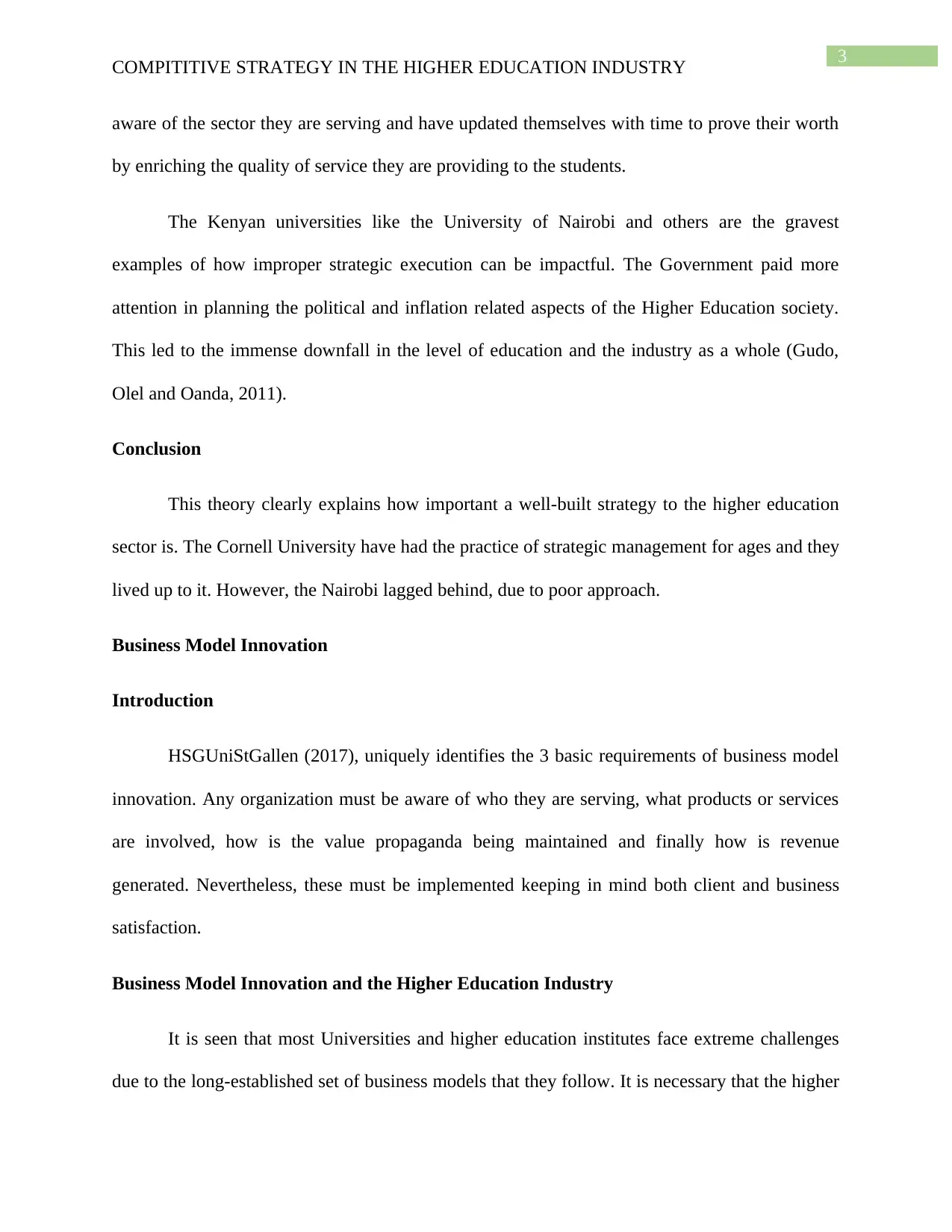
3
COMPITITIVE STRATEGY IN THE HIGHER EDUCATION INDUSTRY
aware of the sector they are serving and have updated themselves with time to prove their worth
by enriching the quality of service they are providing to the students.
The Kenyan universities like the University of Nairobi and others are the gravest
examples of how improper strategic execution can be impactful. The Government paid more
attention in planning the political and inflation related aspects of the Higher Education society.
This led to the immense downfall in the level of education and the industry as a whole (Gudo,
Olel and Oanda, 2011).
Conclusion
This theory clearly explains how important a well-built strategy to the higher education
sector is. The Cornell University have had the practice of strategic management for ages and they
lived up to it. However, the Nairobi lagged behind, due to poor approach.
Business Model Innovation
Introduction
HSGUniStGallen (2017), uniquely identifies the 3 basic requirements of business model
innovation. Any organization must be aware of who they are serving, what products or services
are involved, how is the value propaganda being maintained and finally how is revenue
generated. Nevertheless, these must be implemented keeping in mind both client and business
satisfaction.
Business Model Innovation and the Higher Education Industry
It is seen that most Universities and higher education institutes face extreme challenges
due to the long-established set of business models that they follow. It is necessary that the higher
COMPITITIVE STRATEGY IN THE HIGHER EDUCATION INDUSTRY
aware of the sector they are serving and have updated themselves with time to prove their worth
by enriching the quality of service they are providing to the students.
The Kenyan universities like the University of Nairobi and others are the gravest
examples of how improper strategic execution can be impactful. The Government paid more
attention in planning the political and inflation related aspects of the Higher Education society.
This led to the immense downfall in the level of education and the industry as a whole (Gudo,
Olel and Oanda, 2011).
Conclusion
This theory clearly explains how important a well-built strategy to the higher education
sector is. The Cornell University have had the practice of strategic management for ages and they
lived up to it. However, the Nairobi lagged behind, due to poor approach.
Business Model Innovation
Introduction
HSGUniStGallen (2017), uniquely identifies the 3 basic requirements of business model
innovation. Any organization must be aware of who they are serving, what products or services
are involved, how is the value propaganda being maintained and finally how is revenue
generated. Nevertheless, these must be implemented keeping in mind both client and business
satisfaction.
Business Model Innovation and the Higher Education Industry
It is seen that most Universities and higher education institutes face extreme challenges
due to the long-established set of business models that they follow. It is necessary that the higher
Paraphrase This Document
Need a fresh take? Get an instant paraphrase of this document with our AI Paraphraser
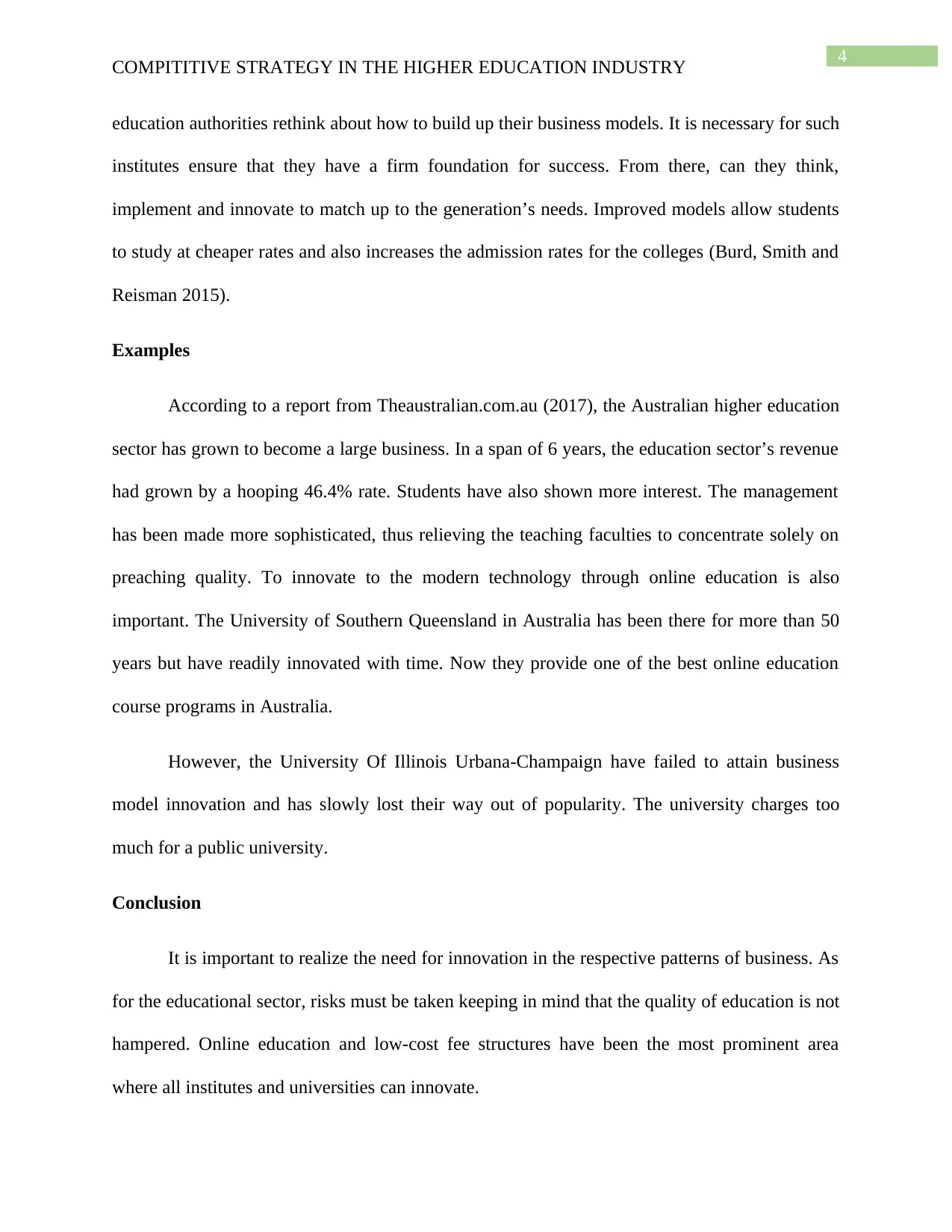
4
COMPITITIVE STRATEGY IN THE HIGHER EDUCATION INDUSTRY
education authorities rethink about how to build up their business models. It is necessary for such
institutes ensure that they have a firm foundation for success. From there, can they think,
implement and innovate to match up to the generation’s needs. Improved models allow students
to study at cheaper rates and also increases the admission rates for the colleges (Burd, Smith and
Reisman 2015).
Examples
According to a report from Theaustralian.com.au (2017), the Australian higher education
sector has grown to become a large business. In a span of 6 years, the education sector’s revenue
had grown by a hooping 46.4% rate. Students have also shown more interest. The management
has been made more sophisticated, thus relieving the teaching faculties to concentrate solely on
preaching quality. To innovate to the modern technology through online education is also
important. The University of Southern Queensland in Australia has been there for more than 50
years but have readily innovated with time. Now they provide one of the best online education
course programs in Australia.
However, the University Of Illinois Urbana-Champaign have failed to attain business
model innovation and has slowly lost their way out of popularity. The university charges too
much for a public university.
Conclusion
It is important to realize the need for innovation in the respective patterns of business. As
for the educational sector, risks must be taken keeping in mind that the quality of education is not
hampered. Online education and low-cost fee structures have been the most prominent area
where all institutes and universities can innovate.
COMPITITIVE STRATEGY IN THE HIGHER EDUCATION INDUSTRY
education authorities rethink about how to build up their business models. It is necessary for such
institutes ensure that they have a firm foundation for success. From there, can they think,
implement and innovate to match up to the generation’s needs. Improved models allow students
to study at cheaper rates and also increases the admission rates for the colleges (Burd, Smith and
Reisman 2015).
Examples
According to a report from Theaustralian.com.au (2017), the Australian higher education
sector has grown to become a large business. In a span of 6 years, the education sector’s revenue
had grown by a hooping 46.4% rate. Students have also shown more interest. The management
has been made more sophisticated, thus relieving the teaching faculties to concentrate solely on
preaching quality. To innovate to the modern technology through online education is also
important. The University of Southern Queensland in Australia has been there for more than 50
years but have readily innovated with time. Now they provide one of the best online education
course programs in Australia.
However, the University Of Illinois Urbana-Champaign have failed to attain business
model innovation and has slowly lost their way out of popularity. The university charges too
much for a public university.
Conclusion
It is important to realize the need for innovation in the respective patterns of business. As
for the educational sector, risks must be taken keeping in mind that the quality of education is not
hampered. Online education and low-cost fee structures have been the most prominent area
where all institutes and universities can innovate.
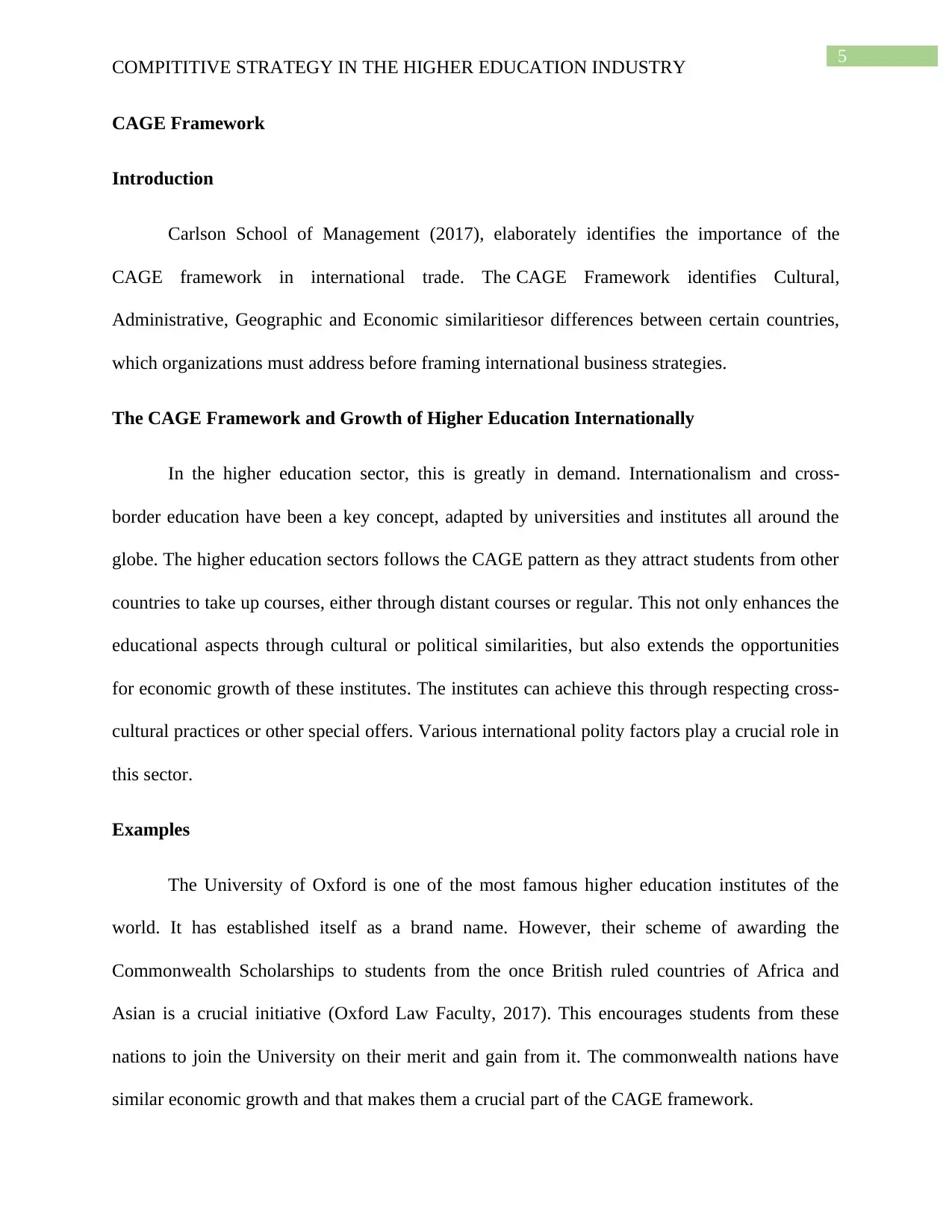
5
COMPITITIVE STRATEGY IN THE HIGHER EDUCATION INDUSTRY
CAGE Framework
Introduction
Carlson School of Management (2017), elaborately identifies the importance of the
CAGE framework in international trade. The CAGE Framework identifies Cultural,
Administrative, Geographic and Economic similaritiesor differences between certain countries,
which organizations must address before framing international business strategies.
The CAGE Framework and Growth of Higher Education Internationally
In the higher education sector, this is greatly in demand. Internationalism and cross-
border education have been a key concept, adapted by universities and institutes all around the
globe. The higher education sectors follows the CAGE pattern as they attract students from other
countries to take up courses, either through distant courses or regular. This not only enhances the
educational aspects through cultural or political similarities, but also extends the opportunities
for economic growth of these institutes. The institutes can achieve this through respecting cross-
cultural practices or other special offers. Various international polity factors play a crucial role in
this sector.
Examples
The University of Oxford is one of the most famous higher education institutes of the
world. It has established itself as a brand name. However, their scheme of awarding the
Commonwealth Scholarships to students from the once British ruled countries of Africa and
Asian is a crucial initiative (Oxford Law Faculty, 2017). This encourages students from these
nations to join the University on their merit and gain from it. The commonwealth nations have
similar economic growth and that makes them a crucial part of the CAGE framework.
COMPITITIVE STRATEGY IN THE HIGHER EDUCATION INDUSTRY
CAGE Framework
Introduction
Carlson School of Management (2017), elaborately identifies the importance of the
CAGE framework in international trade. The CAGE Framework identifies Cultural,
Administrative, Geographic and Economic similaritiesor differences between certain countries,
which organizations must address before framing international business strategies.
The CAGE Framework and Growth of Higher Education Internationally
In the higher education sector, this is greatly in demand. Internationalism and cross-
border education have been a key concept, adapted by universities and institutes all around the
globe. The higher education sectors follows the CAGE pattern as they attract students from other
countries to take up courses, either through distant courses or regular. This not only enhances the
educational aspects through cultural or political similarities, but also extends the opportunities
for economic growth of these institutes. The institutes can achieve this through respecting cross-
cultural practices or other special offers. Various international polity factors play a crucial role in
this sector.
Examples
The University of Oxford is one of the most famous higher education institutes of the
world. It has established itself as a brand name. However, their scheme of awarding the
Commonwealth Scholarships to students from the once British ruled countries of Africa and
Asian is a crucial initiative (Oxford Law Faculty, 2017). This encourages students from these
nations to join the University on their merit and gain from it. The commonwealth nations have
similar economic growth and that makes them a crucial part of the CAGE framework.
⊘ This is a preview!⊘
Do you want full access?
Subscribe today to unlock all pages.

Trusted by 1+ million students worldwide
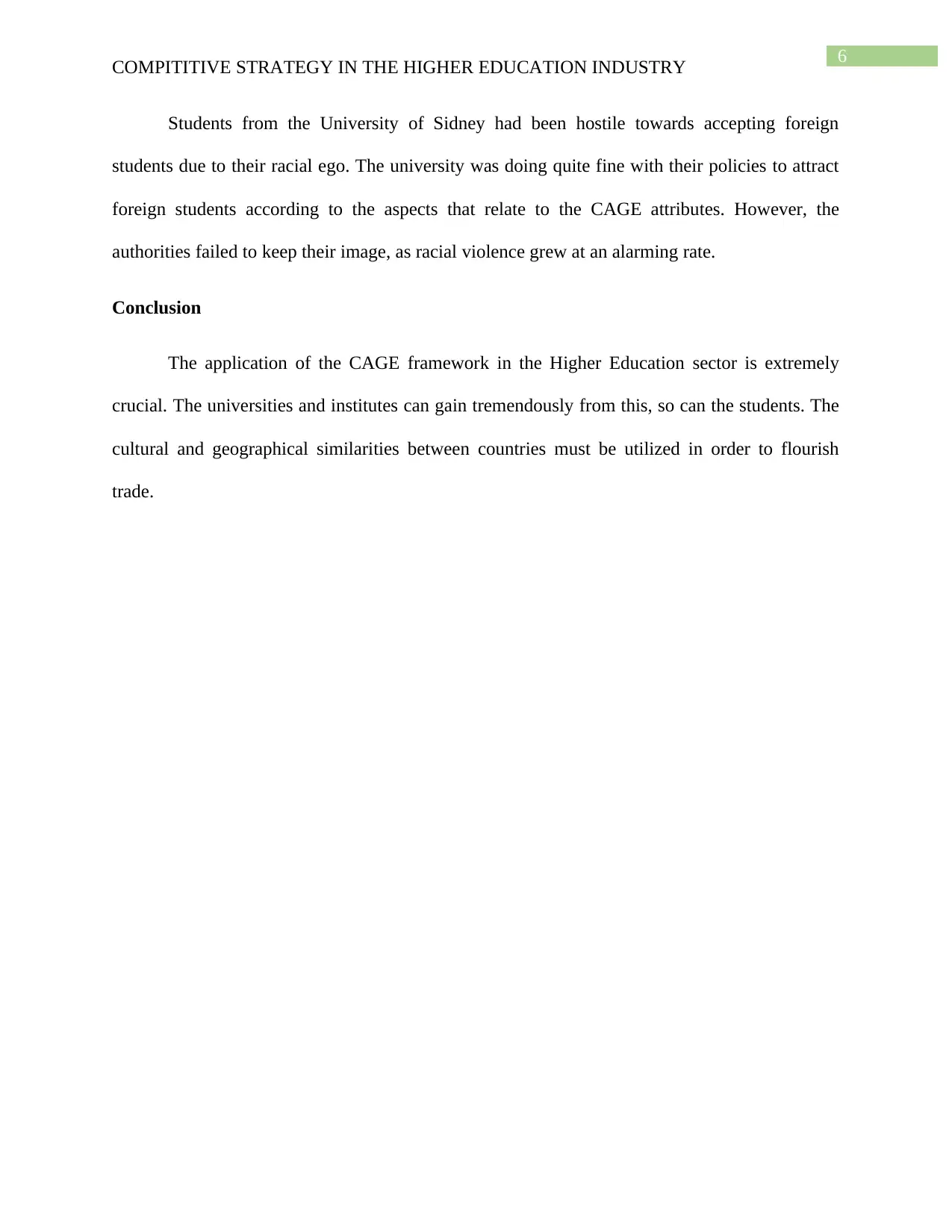
6
COMPITITIVE STRATEGY IN THE HIGHER EDUCATION INDUSTRY
Students from the University of Sidney had been hostile towards accepting foreign
students due to their racial ego. The university was doing quite fine with their policies to attract
foreign students according to the aspects that relate to the CAGE attributes. However, the
authorities failed to keep their image, as racial violence grew at an alarming rate.
Conclusion
The application of the CAGE framework in the Higher Education sector is extremely
crucial. The universities and institutes can gain tremendously from this, so can the students. The
cultural and geographical similarities between countries must be utilized in order to flourish
trade.
COMPITITIVE STRATEGY IN THE HIGHER EDUCATION INDUSTRY
Students from the University of Sidney had been hostile towards accepting foreign
students due to their racial ego. The university was doing quite fine with their policies to attract
foreign students according to the aspects that relate to the CAGE attributes. However, the
authorities failed to keep their image, as racial violence grew at an alarming rate.
Conclusion
The application of the CAGE framework in the Higher Education sector is extremely
crucial. The universities and institutes can gain tremendously from this, so can the students. The
cultural and geographical similarities between countries must be utilized in order to flourish
trade.
Paraphrase This Document
Need a fresh take? Get an instant paraphrase of this document with our AI Paraphraser
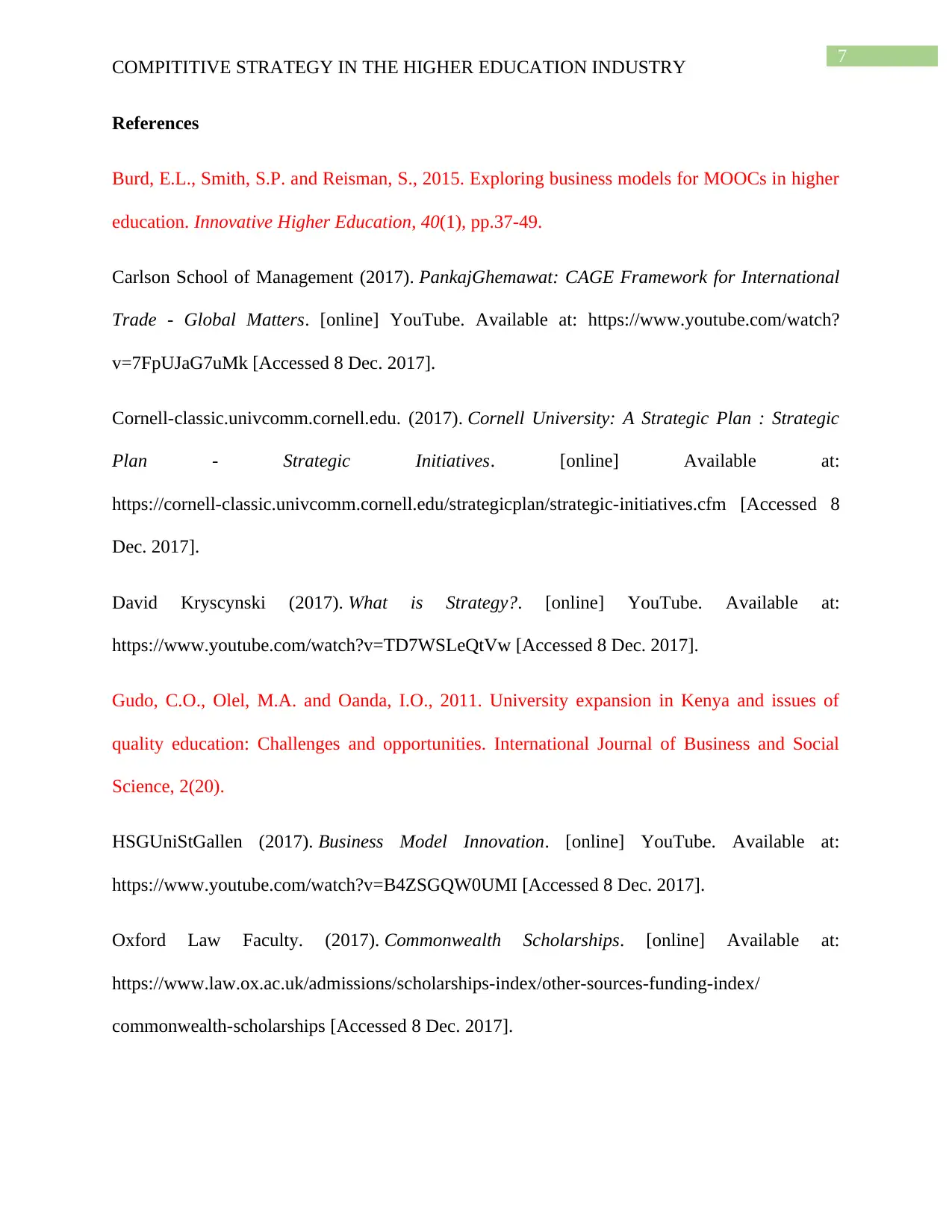
7
COMPITITIVE STRATEGY IN THE HIGHER EDUCATION INDUSTRY
References
Burd, E.L., Smith, S.P. and Reisman, S., 2015. Exploring business models for MOOCs in higher
education. Innovative Higher Education, 40(1), pp.37-49.
Carlson School of Management (2017). PankajGhemawat: CAGE Framework for International
Trade - Global Matters. [online] YouTube. Available at: https://www.youtube.com/watch?
v=7FpUJaG7uMk [Accessed 8 Dec. 2017].
Cornell-classic.univcomm.cornell.edu. (2017). Cornell University: A Strategic Plan : Strategic
Plan - Strategic Initiatives. [online] Available at:
https://cornell-classic.univcomm.cornell.edu/strategicplan/strategic-initiatives.cfm [Accessed 8
Dec. 2017].
David Kryscynski (2017). What is Strategy?. [online] YouTube. Available at:
https://www.youtube.com/watch?v=TD7WSLeQtVw [Accessed 8 Dec. 2017].
Gudo, C.O., Olel, M.A. and Oanda, I.O., 2011. University expansion in Kenya and issues of
quality education: Challenges and opportunities. International Journal of Business and Social
Science, 2(20).
HSGUniStGallen (2017). Business Model Innovation. [online] YouTube. Available at:
https://www.youtube.com/watch?v=B4ZSGQW0UMI [Accessed 8 Dec. 2017].
Oxford Law Faculty. (2017). Commonwealth Scholarships. [online] Available at:
https://www.law.ox.ac.uk/admissions/scholarships-index/other-sources-funding-index/
commonwealth-scholarships [Accessed 8 Dec. 2017].
COMPITITIVE STRATEGY IN THE HIGHER EDUCATION INDUSTRY
References
Burd, E.L., Smith, S.P. and Reisman, S., 2015. Exploring business models for MOOCs in higher
education. Innovative Higher Education, 40(1), pp.37-49.
Carlson School of Management (2017). PankajGhemawat: CAGE Framework for International
Trade - Global Matters. [online] YouTube. Available at: https://www.youtube.com/watch?
v=7FpUJaG7uMk [Accessed 8 Dec. 2017].
Cornell-classic.univcomm.cornell.edu. (2017). Cornell University: A Strategic Plan : Strategic
Plan - Strategic Initiatives. [online] Available at:
https://cornell-classic.univcomm.cornell.edu/strategicplan/strategic-initiatives.cfm [Accessed 8
Dec. 2017].
David Kryscynski (2017). What is Strategy?. [online] YouTube. Available at:
https://www.youtube.com/watch?v=TD7WSLeQtVw [Accessed 8 Dec. 2017].
Gudo, C.O., Olel, M.A. and Oanda, I.O., 2011. University expansion in Kenya and issues of
quality education: Challenges and opportunities. International Journal of Business and Social
Science, 2(20).
HSGUniStGallen (2017). Business Model Innovation. [online] YouTube. Available at:
https://www.youtube.com/watch?v=B4ZSGQW0UMI [Accessed 8 Dec. 2017].
Oxford Law Faculty. (2017). Commonwealth Scholarships. [online] Available at:
https://www.law.ox.ac.uk/admissions/scholarships-index/other-sources-funding-index/
commonwealth-scholarships [Accessed 8 Dec. 2017].
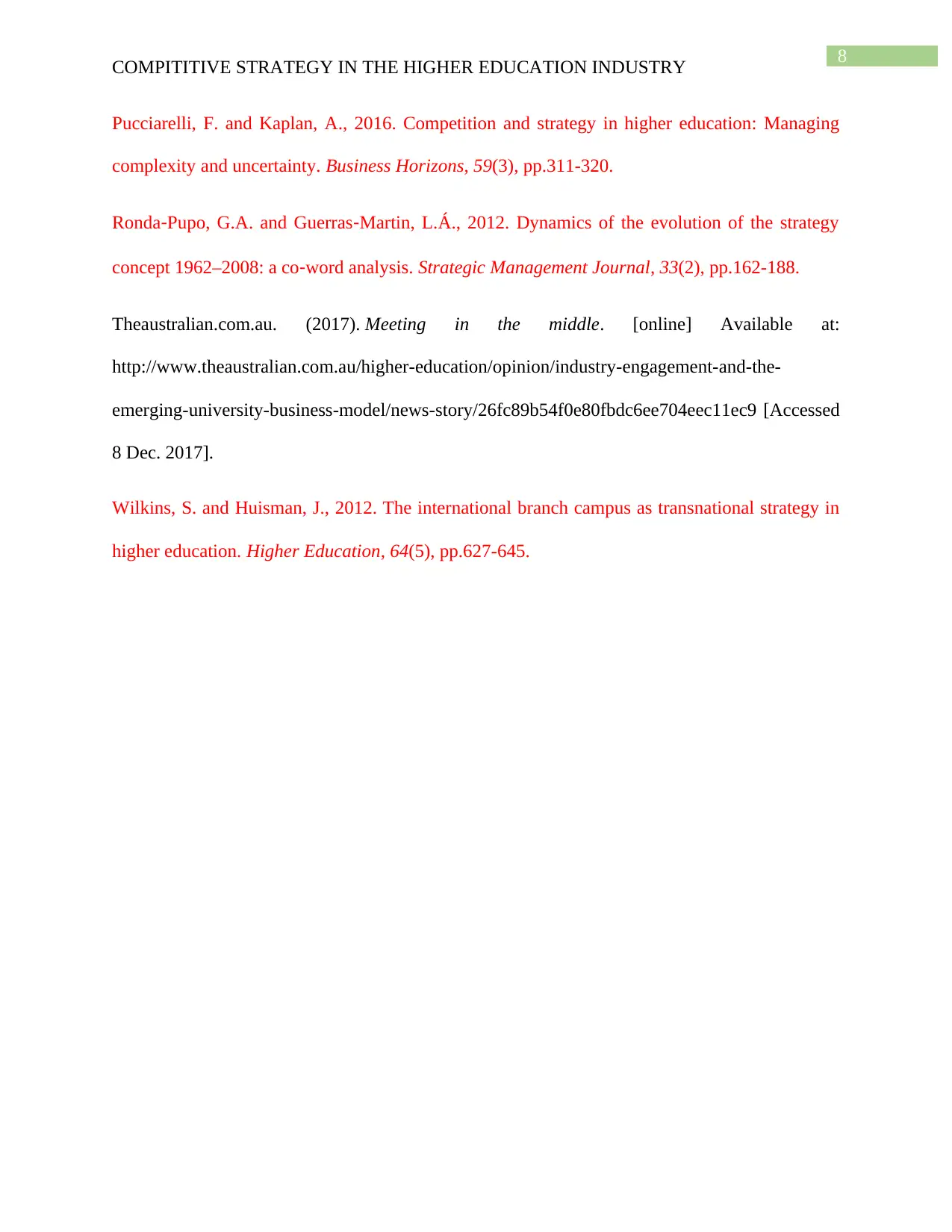
8
COMPITITIVE STRATEGY IN THE HIGHER EDUCATION INDUSTRY
Pucciarelli, F. and Kaplan, A., 2016. Competition and strategy in higher education: Managing
complexity and uncertainty. Business Horizons, 59(3), pp.311-320.
Ronda‐Pupo, G.A. and Guerras‐Martin, L.Á., 2012. Dynamics of the evolution of the strategy
concept 1962–2008: a co‐word analysis. Strategic Management Journal, 33(2), pp.162-188.
Theaustralian.com.au. (2017). Meeting in the middle. [online] Available at:
http://www.theaustralian.com.au/higher-education/opinion/industry-engagement-and-the-
emerging-university-business-model/news-story/26fc89b54f0e80fbdc6ee704eec11ec9 [Accessed
8 Dec. 2017].
Wilkins, S. and Huisman, J., 2012. The international branch campus as transnational strategy in
higher education. Higher Education, 64(5), pp.627-645.
COMPITITIVE STRATEGY IN THE HIGHER EDUCATION INDUSTRY
Pucciarelli, F. and Kaplan, A., 2016. Competition and strategy in higher education: Managing
complexity and uncertainty. Business Horizons, 59(3), pp.311-320.
Ronda‐Pupo, G.A. and Guerras‐Martin, L.Á., 2012. Dynamics of the evolution of the strategy
concept 1962–2008: a co‐word analysis. Strategic Management Journal, 33(2), pp.162-188.
Theaustralian.com.au. (2017). Meeting in the middle. [online] Available at:
http://www.theaustralian.com.au/higher-education/opinion/industry-engagement-and-the-
emerging-university-business-model/news-story/26fc89b54f0e80fbdc6ee704eec11ec9 [Accessed
8 Dec. 2017].
Wilkins, S. and Huisman, J., 2012. The international branch campus as transnational strategy in
higher education. Higher Education, 64(5), pp.627-645.
⊘ This is a preview!⊘
Do you want full access?
Subscribe today to unlock all pages.

Trusted by 1+ million students worldwide
1 out of 9
Related Documents
Your All-in-One AI-Powered Toolkit for Academic Success.
+13062052269
info@desklib.com
Available 24*7 on WhatsApp / Email
![[object Object]](/_next/static/media/star-bottom.7253800d.svg)
Unlock your academic potential
Copyright © 2020–2025 A2Z Services. All Rights Reserved. Developed and managed by ZUCOL.




